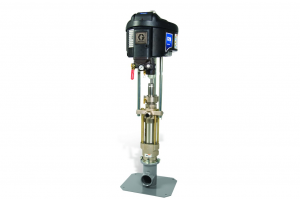June 24, 2014
The 3 Distinct Advantages of Hydraulic Powered Pumps
SHARE THIS POST
Recently, C. H. Reed helped a major printing operation install a new ink pumping system. The new system needed to transfer four colors of high viscosity, heat-set ink to their three presses, drawing the ink from multiple 5,000 gallon tanks. They also needed the ability to maintain operation on a 24/7 basis.
For years, pneumatic-driven pumps were the go-to solution for this type of application, as they are relatively inexpensive and safe to operate. For these reasons, facilities across all kinds of industries employ pneumatic-driven pumps for their fluid-handling operations, disregarding hydraulic pumps as viable options.
There are, however, three distinct advantages that hydraulic pumps have over their popular, air-powered counterparts:
1. Reduced Energy Consumption: Hydraulic pumping systems are up to 80% more efficient than pneumatic systems. To move the high viscosity ink 3 GPM at 1,200 PSI with an air-powered pump, it would require approximately 32 CFM, or the equivalent of 5 HP of electric power. To move the ink at the same flow rate and pressure, a hydraulic pump would only require 1.7 HP of electric power.
2. Better Runaway Control: Running a pump in a dry condition can cause significant damage, forcing you to spend valuable time repairing the pump and replacing parts. In hydraulic systems, the pump speeds are much easier to control than in pneumatic systems. The better flow control enables you to prevent pump runaway and eliminate the damage that can occur to seals, packings and other hard parts while running the pump dry.
3. Reduced Maintenance Costs: In addition to eliminating maintenance costs due to pump runaway, motor maintenance costs are also significantly lower for hydraulic units. Compressed air is easily contaminated with moisture, scale and aerolated oils, leading to more routine maintenance and a higher cost-of-ownership for pneumatic pumps. The compressed air in a pneumatic system can also lead to pump icing, which is caused by exhausting the rapidly cooling compressed air as the pump cycles. Hydraulic pumps eliminate the need for compressed air in the pumping system altogether, removing the chance for pump icing and significantly improving the longevity of their components.
Given the distinct advantages of hydraulic pumps, C. H. Reed implemented Graco Hydraulic-Powered Ink Pumps for this printing operation. The system featured a dual, 25 HP hydraulic power supply module. It included eight floor-stand-mounted checkmate pumps that were powered by hydraulic motors.
These pumps have been in operation for over one year and have required zero maintenance – an unprecedented statistic for pumps that feed three presses. If you have any questions or comments, please leave them below, or contact us directly.
800.692.7216 solutions@chreed.com
Posted by Clinton Shaffer
Search
Categories
Get a consultation
Related Posts
The 3 Distinct Advantages of Hydraulic Powered Pumps
Recently, C. H. Reed helped a major printing operation install a new ink pumping system. The new system needed to transfer four colors of high viscosity, heat-set ink to their three presses, drawing the ink from multiple 5,000…
Simple Ways to Reduce Waste in Your Spray Finishing System
In today’s demanding manufacturing landscape, it can be convenient to adopt a “cut-costs-at-all-costs” mentality, justifying questionable means for the sake of leaner production, a lower bottom line and increased profitability. Regrettably, those efforts can interfere…
What You Need to Know About Air-Powered Pressure Washers
Pressure washers are great solutions for your average cleaning applications, but what tool do you turn to for your more challenging applications? There are many instances where it is simply impossible to use a traditional…
